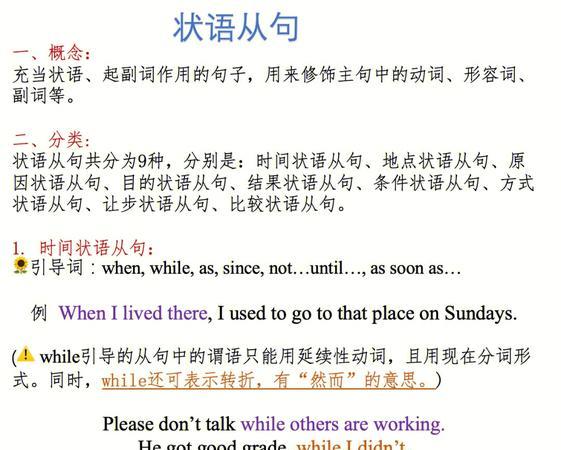状语从句是英语语法中的重要组成部分,用于修饰主句,表示时间、原因、条件、目的和结果。常见的状语从句形式包括时间状语从句(如when, while, as等引导词)、原因状语从句(如because, since等引导词)、条件状语从句(如if, unless等引导词)、目的状语从句(如so that, in order that等引导词)和结果状语从句(如so...that, such...that等引导词)。

1. 时间状语从句
时间状语从句用来表示事件发生的时间。它的常用引导词有when, while, as, before, after, since, until等等。例如:
- I'll call you as soon as I get home.
- She was watching TV when I arrived.
- After she finished her homework, she went to bed.
2. 原因状语从句
原因状语从句用来表示事件发生的原因。它的常用引导词有because, since, as, for等等。例如:
- He didn't come to the party because he was sick.
- Since it's raining heavily, we have to stay at home.
- I'll buy a new computer, for the old one is broken.
3. 条件状语从句
条件状语从句用来表示某种条件下会发生的事情。它的常用引导词有if, unless等等。例如:
- If you study hard, you will pass the exam.
- Unless you finish your work, you can't go out.
- If it rains, we'll stay at home.
4. 目的状语从句
目的状语从句用来表示某种目的或意图。它的常用引导词有so that, in order that等等。例如:
- She's learning English so that she can study abroad.
- He bought a new car in order that he can travel comfortably.
- We need to work hard so that we can achieve our goals.
5. 结果状语从句
结果状语从句用来表示某种结果或后果。它的常用引导词有so...that, such...that等等。例如:
- The movie was so boring that I fell asleep.
- He is such a good teacher that everyone likes him.
- She was so tired that she couldn't walk anymore.
